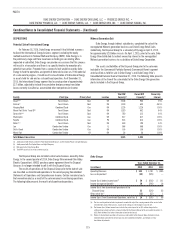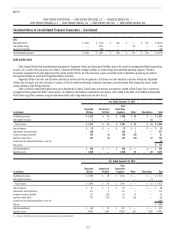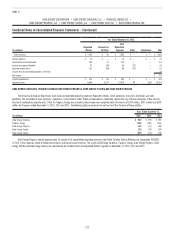Duke Energy 2015 Annual Report Download - page 132
Download and view the complete annual report
Please find page 132 of the 2015 Duke Energy annual report below. You can navigate through the pages in the report by either clicking on the pages listed below, or by using the keyword search tool below to find specific information within the annual report.
112
PART II
DUKE ENERGY CORPORATION • DUKE ENERGY CAROLINAS, LLC • PROGRESS ENERGY, INC. •
DUKE ENERGY PROGRESS, LLC. • DUKE ENERGY FLORIDA, LLC. • DUKE ENERGY OHIO, INC. • DUKE ENERGY INDIANA, INC.
Combined Notes to Consolidated Financial Statements – (Continued)
Pension and Other Post-Retirement Benefit Plans
Duke Energy maintains qualified, non-qualified and other post-retirement
benefit plans. Eligible employees of the Subsidiary Registrants participate in
the respective qualified, non-qualified and other post-retirement benefit plans
and the Subsidiary Registrants are allocated their proportionate share of benefit
costs. See Note 21 for further information, including significant accounting
policies associated with these plans.
Severance and Special Termination Benefits
Duke Energy has a severance plan under which, in general, the longer
a terminated employee worked prior to termination the greater the amount
of severance benefits. A liability for involuntary severance is recorded once
an involuntary severance plan is committed to by management if involuntary
severances are probable and can be reasonably estimated. For involuntary
severance benefits incremental to its ongoing severance plan benefits, the fair
value of the obligation is expensed at the communication date if there are no
future service requirements, or over the required future service period. From
time to time, Duke Energy offers special termination benefits under voluntary
severance programs. Special termination benefits are recorded immediately upon
employee acceptance absent a significant retention period. Otherwise, the cost
is recorded over the remaining service period. Employee acceptance of voluntary
severance benefits is determined by management based on the facts and
circumstances of the benefits being offered. See Note 19 for further information.
Guarantees
Liabilities are recognized at the time of issuance or material modification
of a guarantee for the estimated fair value of the obligation it assumes. Fair
value is estimated using a probability-weighted approach. The obligation is
reduced over the term of the guarantee or related contract in a systematic and
rational method as risk is reduced. Any additional contingent loss for guarantee
contracts subsequent to the initial recognition of a liability is accounted for and
recognized at the time a loss is probable and can be reasonably estimated. See
Note 7 for further information.
Stock-Based Compensation
Stock-based compensation represents costs related to stock-based
awards granted to employees and Duke Energy Board of Directors (Board of
Directors) members. Duke Energy recognizes stock-based compensation based
upon the estimated fair value of awards, net of estimated forfeitures at the
date of issuance. The recognition period for these costs begins at either the
applicable service inception date or grant date and continues throughout the
requisite service period, or, for certain share-based awards, until the employee
becomes retirement eligible, if earlier. Compensation cost is recognized as
expense or capitalized as a component of property, plant and equipment. See
Note 20 for further information.
Income Taxes
Duke Energy and its subsidiaries file a consolidated federal income
tax return and other state and foreign jurisdictional returns. The Subsidiary
Registrants entered into a tax-sharing agreement with Duke Energy. Income
taxes recorded represent amounts the Subsidiary Registrants would incur
as separate C-Corporations. Deferred income taxes have been provided for
temporary differences between GAAP and tax bases of assets and liabilities
because the differences create taxable or tax-deductible amounts for future
periods. Deferred taxes are not provided on translation gains and losses when
earnings of a foreign operation are expected to be indefinitely reinvested.
Investment tax credits (ITC) associated with regulated operations are deferred
and amortized as a reduction of income tax expense over the estimated useful
lives of the related properties.
Positions taken or expected to be taken on tax returns, including the
decision to exclude certain income or transactions from a return, are recognized
in the financial statements when it is more likely than not the tax position can
be sustained based solely on the technical merits of the position. The largest
amount of tax benefit that is greater than 50 percent likely of being effectively
settled is recorded. Management considers a tax position effectively settled
when: (i) the taxing authority has completed its examination procedures,
including all appeals and administrative reviews; (ii) the Duke Energy
Registrants do not intend to appeal or litigate the tax position included in the
completed examination; and (iii) it is remote the taxing authority would examine
or re-examine the tax position. The amount of a tax return position that is not
recognized in the financial statements is disclosed as an unrecognized tax
benefit. If these unrecognized tax benefits are later recognized, then there will be
a decrease in income taxes payable, an income tax refund or a reclassification
between deferred and current taxes payable. If the portion of tax benefits
that has been recognized changes and those tax benefits are subsequently
unrecognized, then the previously recognized tax benefits may impact the
financial statements through increasing income taxes payable, reducing income
tax refunds receivable or changing deferred taxes. Changes in assumptions on
tax benefits may also impact interest expense or interest income and may result
in the recognition of tax penalties.
Tax-related interest and penalties are recorded in Interest Expense and
Other Income and Expenses, net, in the Consolidated Statements of Operations.
See Note 22 for further information.
Accounting for Renewable Energy Tax Credits and Cash Grants
When Duke Energy receives ITC or cash grants on wind or solar facilities,
it reduces the basis of the property recorded on the Consolidated Balance
Sheets by the amount of the ITC or cash grant and, therefore, the ITC or grant
benefit is recognized through reduced depreciation expense. Additionally, certain
tax credits and government grants result in an initial tax depreciable base in
excess of the book carrying value by an amount equal to one half of the ITC or
government grant. Deferred tax benefits are recorded as a reduction to income
tax expense in the period that the basis difference is created.
Excise Taxes
Certain excise taxes levied by state or local governments are required to
be paid even if not collected from the customer. These taxes are recognized on a
gross basis. Otherwise, the taxes are accounted for net. Excise taxes accounted
for on a gross basis as both operating revenues and property and other taxes in
the Consolidated Statements of Operations were as follows.
Years Ended December 31,
(in millions) 2015 2014 2013
Duke Energy $ 396 $ 498 $ 602
Duke Energy Carolinas 31 94 164
Progress Energy 229 263 304
Duke Energy Progress 16 56 115
Duke Energy Florida 213 207 189
Duke Energy Ohio 102 103 105
Duke Energy Indiana 34 38 29
























